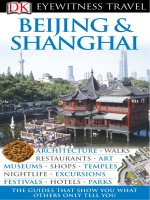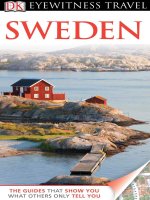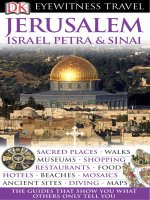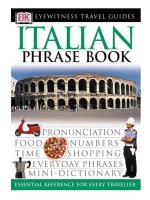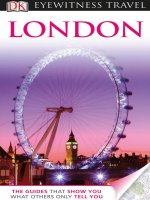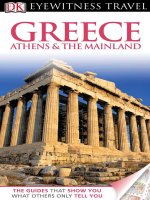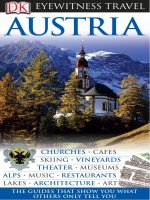Greek Islands Eyewitness Travel
Bạn đang xem bản rút gọn của tài liệu. Xem và tải ngay bản đầy đủ của tài liệu tại đây (47.35 MB, 410 trang )
EYEWITNESS TRAVEL
THE GREEK
ISLANDSEYEWITNESS TRAVEL
THE GREEK
ISLANDS
MAIN CONSULTANT: MARC DUBIN
Fishermen unloading their catch at Mýkonos harbour in the Cyclades
The information in this
DK Eyewitness Guide is checked regularly.
Every effort has been made to ensure that this book is as up-to-date
as possible at the time of going to press. Some details, however,
such as telephone numbers, opening hours, prices, gallery hanging
arrangements and travel information are liable to change. The
publishers cannot accept responsibility for any consequences arising
from the use of this book, nor for any material on third party
websites, and cannot guarantee that any website address in this book
will be a suitable source of travel information. We value the views
and suggestions of our readers very highly. Please write to: Publisher,
DK Eyewitness Travel Guides, Dorling Kindersley, 80 Strand, London
WC2R 0RL. Great Britain, or email:
The Turkish Prince Cem arriving in
Rhodes (15th century)
INTRODUCING THE
GREEK ISLANDS
DISCOVERING THE
GREEK ISLANDS 10
CHOOSING YOUR
ISLAND 12
PUTTING GREECE ON
THE MAP 14
A PORTRAIT OF
THE GREEK ISLANDS 16
THE HISTORY
OF GREECE 26
The harbour at Réthymno, Crete
CONTENTS
HOW TO USE THIS
GUIDE 6
PROJECT EDITOR Jane Simmonds
ART EDITOR Stephen Bere
EDITORS Isabel Carlisle, Michael Ellis, Simon Farbrother,
Claire Folkard, Marianne Petrou, Andrew Szudek
US EDITORS Michael Wise, Mary Sutherland
DESIGNERS Jo Doran, Paul Jackson, Elly King, Marisa Renzullo
MAP CO-ORDINATORS Emily Green, David Pugh
VISUALIZER Joy Fitzsimmons
LANGUAGE CONSULTANT Georgia Gotsi
CONTRIBUTORS AND CONSULTANTS
Rosemary Barron, Marc Dubin, Stephanie Ferguson, Mike Gerrard, Andy
Harris, Lynette Mitchell, Colin Nicholson, Robin Osborne, Barnaby
Rogerson, Paul Sterry, Tanya Tsikas
MAPS
Gary Bowes, Fiona Casey, Christine Purcell (ERA-Maptec Ltd)
PHOTOGRAPHERS
Max Alexander, Joe Cornish, Paul Harris, Rupert Horrox,
Rob Reichenfeld, Linda Whitwam, Francesca Yorke
ILLUSTRATORS
Stephen Conlin, Steve Gyapay, Maltings Partnership, Chris Orr &
Associates, Mel Pickering, Paul Weston, John Woodcock
Reproduced by Colourscan (Singapore)
Printed and bound in China by L. Rex Printing Co.Ltd
First American Edition, 1997
11 12 13 14 10 9 8 7 6 5 4 3 2 1
Published in the United States by
DK Publishing, 375 Hudson Street,
New York, New York 10014
Reprinted with revisions 1998, 1999, 2000,
2001, 2002, 2003, 2004, 2006, 2007, 2009, 2011
Copyright © 1997, 2011 Dorling Kindersley Limited, London
ALL RIGHTS RESERVED. WITHOUT LIMITING THE RIGHTS UNDER COPYRIGHT RESERVED
ABOVE, NO PART OF THIS PUBLICATION MAY BE REPRODUCED, STORED IN OR
INTRODUCED INTO A RETRIEVAL SYSTEM, OR TRANSMITTED IN ANY FORM OR BY ANY
MEANS, (ELECTRONIC, MECHANICAL, PHOTOCOPYING, RECORDING OR OTHERWISE),
WITHOUT THE PRIOR WRITTEN PERMISSION OF BOTH THE COPYRIGHT OWNER AND
THE ABOVE PUBLISHER OF THIS BOOK.
PUBLISHED IN GREAT BRITAIN BY DORLING KINDERSLEY LIMITED.
ISSN: 1542-1554
ISBN: 978-0-75667-020-7
FLOORS ARE REFERRED TO THROUGHOUT IN ACCORDANCE WITH EUROPEAN
USAGE; IE THE “FIRST FLOOR” IS THE FLOOR ABOVE GROUND LEVEL
Front cover main image: Shipwreck Bay (Navaghio), Zakynthos
THE GREEK ISLANDS
THROUGH THE YEAR 46
ANCIENT GREECE
GODS, GODDESSES
AND HEROES 54
THE TROJAN WAR 56
GREEK WRITERS AND
PHILOSOPHERS 58
TEMPLE
ARCHITECTURE 60
VASES AND VASE
PAINTING 62
Garídes saganáki, prawns with
feta in a tomato sauce
Gorgon’s head from Evvoia
Kámpos beach on Ikaría in the
Northeast Aegean Islands
BEACHES AND
WATERSPORTS 348
SURVIVAL GUIDE
PRACTICAL
INFORMATION 352
TRAVEL
INFORMATION 362
GENERAL INDEX 372
PHRASE BOOK 404
MAP OF FERRY ROUTES
Inside back cover
Néa Moní on
Chíos, Northeast
Aegean Islands
THE GREEK
ISLANDS AREA BY
AREA
THE GREEK ISLANDS AT
A GLANCE 66
THE IONIAN ISLANDS 68
THE ARGO-SARONIC
ISLANDS 92
SPECIALIST HOLIDAYS
& OUTDOOR
ACTIVITIES 344
THE SPORADES
AND EVVOIA 104
THE NORTHEAST
AEGEAN ISLANDS 124
THE DODECANESE 158
THE CYCLADES 204
CRETE 244
A SHORT STAY IN
ATHENS 282
TRAVELLERS’
NEEDS
WHERE TO STAY 298
WHERE TO EAT 322
SHOPPING IN GREECE
342
Family on a
scooter
" !! %
For hotels and restaurants in this region see pp30912 and pp3346
Púthia
"-*(&5.9&1&3)2&.354794+
9-*.81&3).8&':8><470.3,
-&7'4:7$*),*)'*9<**3
9<424:39&.389-*94<38
'7.,-91>5&.39*)-4:8*8(:7;*
&74:3)9-*'&>
D9 &.8-42*947**(*8
1&898543,*+1**9&3)9-*7*.8&
8543,*).;.3,8(-441439-*
*&89*738.)*4+9-*-&7'4:7
"-*<&9*7+7439.81.3*)<.9-
(&+A8&3)9-*2&.31&3)2&708
&7*9-*5.30)42*)9&1.&3&9*
':.1).3,8.3(1:).3,9-*41)
Governors Palace
< (-34<
-4:8*89-*2&70*9&3)9-*
8.1;*7)42*)(&9-*)7&14+
Agios Christús
41>-7.89
" 89-(*39:7>
(&9-*)7&1-&8&7*7*)48
8(7**3'* 3)9-*&19&7
'>.&334E1.8-&1*5@8
" "-**72&.)&99-*
-&7'4:7.843*4+<4708
9-&9<*7*)43&9*)949-*
.81&3)'>14(&18(:1594787*3*
&3).(
"-*
Archaeological
Museum
-4:8*).3&*4
1&88.(&12&38.43-&8'**3
<*89(4&89"-*8:38*94;*7
9-*.81*94+"A1*3)48+742
Myrtiộs
.843*4+@1>23488
2489+&24:88.,-9819-4:,-
>79.A8&3)3*.,-'4:7.3,
&84E7.-&;*34<,74<3.394
34.8>94:7.89(*397*89-*
72*D8*3)4+&84E7..81*88
+7*3*9.("49-*3479-.89-*
+479.+.*)
Kastộlli
9-*7*+:,*4+
8:7;.;478+7429-*9-(*39:7>
":70.8-2&88&(7*"-*(4&89
74&)+742-*7*.885*(9&(:1&7
5&88.3,+.8-+&728.31*98
&3)9-*+/47)1.0*'*&(-&9
Arginúnta
;.8.9949-*
3479-*732489+.8 3,-&21*9
Emporeiús
2&0*8&,44))&>
4:9&3).8.3(7&,,><&10.3,
(4:397>%4:(&3<&1094
Kolonústilo
9-*>(1458
&;*< (-.83&2*)&+9*7
.982&88.;*89&1&(9.9*8
39-*84:9-*&89.89-*2489
'*&:9.+:1&7*&4+@1>2348
9-*1:8-#&9-F;&11*>< (-
-&89-7**82&11;.11&,*8&99-*
-*&)4+&89:33.3,'1:*.31*9
&(0*)'>(.97:8,74;*8
Rớna
3&2*)&+9*7!97*3*.8&
57*99>-&21*9<.9-&<470.3,
'4&9>&7)
Plỏtanos
9-*3*=9
;.11&,*-&8&-:,*51&3*97**
&3)9-*7*2&.384+>(145*&3
<&118"-*7*.8&-4:797&.1
+742-*7*;.&
Metúchi
9-*
9 7)#&9-F;.11&,*&(74889-*
.81&3)947,.3D39&
&C6:*8+742 B3&;.8.99-*
Daskaliú Cave
.39-*8.)*4+
9-*8-**7.31*9&3)72.A8
7&8D3.&&3)&1&.D3.8848
'*&(-*8439-**&89(4&89
1&;.8-1>7*(43897:(9*)&3)9-*7*
.8&(411*(9.434+*41.9 (&3)
743?*,*+.3)8+7429-*
.81&3)51:814(&12*247&'.1.&
"-*
Sponge Factory
/:894++
1&9*B&1*+9-*7B&8-&8&(42
51*9* 8947>4+8543,*8
Archaeological Museum
Near Plateớa Kprou. Tel 22430 23113
.
TueSun.
main public hols.
Sponge Factory
Plateớa Eleftherớas.
Tel
22430 28501.
daily.
main public hols.
SPONGE FISHING AROUND KALYMNOS
@1>2348-&8'**3&8543,*+.8 3,(*397*+742
&3(.*399.2*8&19-4:,-+.8 3,7*897.(9.438&3)
8543,*'1.,-9-&;* 99-*97&)*.3
7*(*39>*&783(*
.3,7*&9)*2&3)8543,*8<*7*:8*)
+479-*!:19&38-&7*2+475&)).3,.3
&724:7&3)1&9*7+47(482*9.(&3)
.3):897.&15:7548*8.;*78<*7*
<*.,-*))4<3<.9-74(0847:8*)(7:)*&.7
&55&7&9:8&3)2&3>2*3<*7*)74<3*)47).*)
4+9-*'*3)8"-*<**0'*+47*@1>23488+1**9
8*984:994+.8-.89-* !"47
!543,*$**0*89.;&1.;*78
&7*,.;*3&(*1*'7&947>8*3)4++
<.9-+44))7.30&3))&3(.3,
.397&).9.43&1(489:2*
&24:894)&>&89-*8543,*+.8 3,.81&3)@1>23488
8947>(&3'*97&(*)'&(094&*41.9 (8*991*2*39.3
#49-F34.3*&7D9 &.9<&8(4143.?*)&+9*79-*
)*;&89&9.434+7*9*"-*5*451*-&;*'**3034<3+47
9-*.77*8.1.*3(*8.3(*9-*9-(*39:7>2&88&(7*'>
9-*!*1/:0":708< (-
&+*<8:7;.;*).3
+479.+.*)&89A11.
Diving equipment
%!!#'%!
#'!"!'%"$#"&!
!!$!%"&#$
#"$""" '
#" #!'#(#
"#"&!%!""#!&!"
The Mermaid at
Púthia harbour
Around the Island
@1>2348.8*&8>94,*9&74:3)
<.9-&,44)':88*7;.(*949-*
;.11&,*8&3)3:2*74:89&=.8
" 874(0>.81&3)-&89-7**
24:39&.37&3,*89-*5*&08
4++8*9'>)**5+/47)1.0*.31*98
479-<*894+D9 &9-*8:'
:7'4+F14.<.9-.989-7**
)*7*1.(9<.3)2.118'1*3)8.394
Choriú
9-*57*99>< 9*94<3
&3)+472*7(&5.9&1
39-*<&>89&3)
.3,949-*1*+9.89-*
7:.3*)
Castle of the
Knights
&3)&'4;*
;.&89*58+742-47.D
.89-*(.9&)*14+
Pộra
Kỏstro
4114<.3,&
":70.8-&99&(09 8
+479.+.*);.11&,*
<&8.3-&'.9*)
+7429-*9-94
9-*9-(*39:7>9
-&8,44);.*<8&3)
3.3*< 9*(-&5*18
89&3)439-*(7&,8
"-*
Cave of Seven Virgins
59@&79-A3438-4<897&(*8
4+3>25-<478 5*,*3)-&8
.99-&99-*8*;*3;.7,.38 )-*7*
+7425.7&9*8':9).8&55*&7*).3
9-*'499421*88(-&33*1'*14<
"-*2&.37*84798439-*
.81&3)&7*897:3,4:9&143,9-*
Outlying Islands
=(:78.43'4&981*&;*D9 &
)&.1>+47
Psộrimos
&3)9-*
.81*94+
Nerỏ
<.9-.9843B
!9&;74E8A7.248-&8&3
4+9*3':8>8&3)>'*&(-&3)
&545:1&7+*89.;&14+9-*
88:259.4343:,:89
Tộlendos
7*&(-*)+742
>79.A8.85*7+*(9+47& )*
&<&>-41.)&><.9-&+*<
74428947*39&3)&-&3)+:1
4+9&;*73&851:88 3,1>
'*&(-*8"-*7*&7* 42&3
7:.38&)*7*1.(9+479&3)9-*
7:.3*)43B,B4:#&8.1*B4:
)&9.3,+7429-*.))1*,*8
"-*>?&39.3*(&891*4+,.48
4389&39B348&18489&3)8-*7*
14,000.
Púthia.
behind marketplace, Púthia.
Plateớa Taxi, Púthia (22430
59141).
Púthia: MonSat.
Easter celebrations around
island: Easter Sat; Sponge week
at Púthia: week following
Greek Easter.
View of Púthia and harbour
The deep Vathý inlet with the settlement of Rớna at its head
Sea sponge
This black-figure
!
%" #"!'
" %"
%! #$!"#
##!###"
! !##!#"
#"!!" "
%"#"#
!$
KEY
For key to map see back flap
A stone was used
94<*.,-).;*78
940**59-*23*&7949-*8*&'*)
0 kilometres
0 miles
5
3
Piraeus
Astypỏlaia
TELENDOS
NERA
Myrtiộs
Cave of
Seven Virgins
Kolonústilo
Armiộs
Pộra
Kỏstro
Metúchi
Daskaliú
Cave
Kamỏri
Ka
stộlli
Palaiúnissos
Pỏnormos
Kos,
Nớsyros,
Psộrimos
Rớna
Vothýnoi
Choriú
Castle of
the Knights
Plỏtanos
Lộros
Emporeiús
Arginúnta
Masoỳri
POTHIA
Drasúnia
Armeús
HOW TO USE THIS GUIDE6
artifacts to be seen. The seven regional
chapters, plus A Short Stay in Athens,
describe important sights, with maps
and illustrations. Restaurant and hotel
recommendations can be found in
Travellers Needs. The Survival Guide
has tips on everything from the Greek
telephone system to transport networks.
T
his guide helps you to get the
most from your visit to the Greek
Islands. Introducing the Greek
Islands maps the country in its histori-
cal and cultural context, including a
quick comparison chart with Choosing
Your Island. Ancient Greece gives a
background to the many remains and
HOW TO USE THIS GUIDE
1
Introduction
The landscape, history and
character of each island group
is described here, showing how
they have developed over the
centuries and what they offer
to the visitor today.
Story boxes
highlight
special or unique aspects
of a particular sight.
Each island group
can be
quickly identified by its
colour coding.
A locator map
shows you
where you are in relation
to other island groups.
THE GREEK ISLANDS
AREA BY AREA
The islands have been
divided into six groups,
each of which has a
separate chapter. Crete
has a chapter on its own.
A map of these groups
can be found inside the
front cover of the book.
Each island group is
colour coded for easy
reference.
2
Regional Map
This shows all the
islands covered in the
chapter. Main ferry routes are
marked and there are useful tips
on getting around the islands.
Islands at a Glance
lists the islands
alphabetically. Each island has a
cross reference to its entry.
The main ferry
routes
, roads and
transport points
are marked on
each map.
A locator map
shows you where
you are in relation
to other islands in
the group.
3
Detailed information
Most of the islands are
described individually. Within
each island entry there is
detailed information on all the
sights. Major islands have an
island map showing all the
main towns, villages, sights
and beaches.
1JSBFVT
$SFUF
$SFUF
1JSBFVT
1JSBFVT
4õSPT
/BYPT
4ẩNPT
1JSBFVT
.õLPOPT
1JSBFVT
"NPSHỉT
3IPEFT
,PTLJOPị
'BMJSẩLJ
1FUBMPịEFT
5SJẩOEB
,BMBWẩSEB
4LẩMB
,BNFểSPV
$IBSẩLJ
-ểOEPT
"SDIẩOHFMPT
4õNJ5PXO
1BOPSNểUJT
"HểB.BSểOB
-JWẩEJB
.FHẩMP
$IPSJỉ
.BOESẩLJ
,PT5PXO
"OUJNẩDIFJB
.BTUJDIẩSJ
5JHLẩLJ
"TLMFQJFểPO
,BSEẩNBJOB
,BNẩSJ
/JLJẩ
1ẩMPJ
.BMUF[ẩOB
"TUZQẩMBJB5PXO
-JWẩEJ
7BUIõ
1ỉUIJB
3ểOB
.ZSUJẽT
"SHJOỉOUB
-BLLể
"MểOEB
-JQTể5PXO
4LẩMB
(SểLPT
-ẩNQJ
,BUUBWJB
(FOOẩEJP
"QPMBLLJẩ
.POỉMJUIPT
/JNQPSJỉ
-ẩFSNB
&NQPOBT
%JBGẩOJ
-FGLỉT
0MZNQPT
"QẽMMB
"QẽSJ
"SLẩTB
,ẩSQBUIPT
5PXO
.FOFUẽT
'Sõ
0ROFểTIS)LểAS
M
!TAVIROS
M
!GATHONISI
,IPSể
!RKI
0ẩTMOS
+ẩLYMNOS
,ẽROS
0SẽRIMOS
3õRNA
+ANDELIOUSA
!NTITểLOS
+OS
.ểSYROS
4ểLOS
3õMI
+ẩRPATHOS
+ASOS
3ARIẩ
!RMẩTHIA
2HODES
#HẩLKI
!LIMIẩ
!STYPẩLAIA
SEE ALSO
00;
00;
00;
For additional map symbols see back flap
ISLANDS AT A GLANCE
3490<,!)!
(<,+)
<,9 /3
<20!4(/3
!34%,,?2):/
/3
=2/3
)03>
>392/3
<4-/3
@-)
>,/3
(%/$%#!.%3%/&&%2!.
5.0!2!,,%,%$2!.'%/&
,!.$3#!0%3!.$!#4)6)4)%3
(%2%!2%"%!54)&5,"%!#(%3
7)4(!,,+).$3/&7!4%230/243
3!&%9!#(4).'(!2"/523,53(
6!,,%93!.$"!22%.-/5.4!).3
#!6%3!.$&*/2$3!.$%6%.4(%
3%-)!#4)6%6/,#!.//.>392/3
)34/2)#!,3)'(43).4(%'2/50
!2%*534!3$)6%23%).#,5$).'
4(%4(#%.4529/.!34%29
/&4/(./.<4-/34(%
%,,%.)34)#3+,%0)%)/./&/3
4(%-%$)%6!,7!,,%$#)49/&
4(%.)'(43/&(/$%3!.$4(%
5.)15%42!$)4)/.!,6),,!'%/&
,9-0/3/.<20!4(/3()3
)3,!.$'2/50$)6)$%3
.%!4,9
).4/./24(!.$3/54(
/3).4(%./24(!.$
(/$%34(%'2/503
#!0)4!,).4(%3/54(
-!+%'//$"!3%3&/2
!)2!.$&%22942!6%,
GETTING AROUND
/3(/$%3!.$<20!4(/3(!6%).4%2.!4)/.!,
!)20/2434(/3%!4=2/33490<,!)!!.$<3/3
!2%$/-%34)#2!6%,,).'"93%!)4)37)3%4/
0,!.7(%2%9/57!.44/'/!33/-%)3,!.$3
$/./43(!2%$)2%#4#/ %#4)/.3%6%.7(%.
15)4%#,/3%,3/*/52.%93#!."%,/.';)4
4!+%3.).%(/523&2/-(/$%34/<4-/3&
0/33)",%!,,/74)-%&/2#(!.'%3).4(%7%!4(%2
(%#//,).'
7).$)37%,#/-%).4(%
()'(35 %2"54)&342/.'#!.-%!.&%22)%3
7),,./4/0%2!4%!.$%6%.,%!6%9/5342!.$%$
533%26)#%3!2%'//$%30%#)!,,9/.4(%,!2'%2
)3,!.$3!.$4(%2%!2%!,7!93#!23!.$")+%3&/2
()2%/24!8)3!6!),!",%4(/5'(
4(%34!.$!2$/&2/!$3
#!.6!29
The domed entrance to the New Market
in Rhodes town
LOCATOR MAP
An aerial view of Sými town with its Neo-Classical houses
KEY
Main road
Minor road
Scenic route
High season, direct ferry route
Summit
2O
+ASTELLỉRIZO
3TRONGYLể
,BTUFMMỉSJ[P
3IPEFT
0 kilometres
0 miles
25
15
!
A faỗade on the waterfront of Sými
One monks method of travelling aro
: : :!:: !:!
: !: : : ":
6' 51 5*'+3 &+45#0%'(31/ 5*'04
#0&/#+0.#0&3''%'5*'4'+4.#0&4
*#7' $''0 46$,'%5 51 # 06/$'3
1( +07#4+104 8+5* 53#%'4 1(
1%%62#5+10 .'(5 $'*+0& 10
'7'39 +4.#0& *' .#44+%#.
5'/2.'4 $6+.5 $9 5*'13+#04
%#0 $' 4''0 10 *1&'4
*' 0+)*54 1( 5
1*0 8'3'
5*' /145 (#/164 +07#&'34
#33+7+0) +0 #0&45#9+0)
605+.5*'98'3'&'('#5'&$96.'+/#0
5*'#)0+(+%'05+0
551/#0#3%*+5'%563'+4/145231/+
0'0510.#3)'38'#.5*+'3+4.#0&446%*
#4 14#0&*1&'4 (5'3%'0563+'41(
63-+4* 36.' 5*' 5#.+#04 #33+7'& +0
#0&$')#0#3')+/' 1(2'34'%6
5+10 6441.+0+ $6+.5 /#09+/214+0)
26$.+%$6+.&+0)4015#$.9+05*'5180
1( # =10<314
(5'39'#341(1%%6
2#5+105*'+4.#0&48'3'(+0# 960+5'&
8+5*5*'3''-45#5'+0
'1)3#2*+%# 95*'1&'%#0'4'
7#39 &3#/#5+%# 9 +0 %*#3#%
5'341/' #3' &39 45#3- #0&
$#33'0 46%* #4 *; + #0&
;4148*+.' =.14#0&71.%#0+%
=49314 #3' ('35+.'#0& )3''0
4592;.#+# #0& ;5/14 8+5*
5*'+3 8*+5'8#4*'& *164'4
%.14'.9 3'4'/$.' 9%.#&+%
+4.#0&4 5*' 2#.'*164'4 1(
*>3# 10 ;5/14 #3' 42'%
5#%6.#3.9 17'34*#&18'& $9 5*'-
/10#45'39 1( 5 1*0 *1&'4 +4 5*'
5*'%#2+5#.1(5*'+4.#0&)3162#0&+4
10' 1( 5*' /145 2126.#3 *1.+	
&'45+0#5+104&6' 51 +54'0&.'444#0&9
$'#%*'4#0&/#094+)*54
*'%.+/#5'1(5*'4'+4.#0&445#94*15
8' +0515*'#656/0 2317+&+0)#.10)
4'#410+0 8*+%* 51 '0,19 5*' $'#%*'4
*'4'7#39 (31/ $.#%-2'$$.'4 51 4+.
7'34#0&4 #0& &'4'35'&$#94 51 4*+0
).'453+242#%-'&8+5*460$#5*'34
A statue at Mandrỏki
harbour in Rhodes
HOW TO USE THIS GUIDE 7
The main ferry routes
,
roads, transport points and
recommended beaches are
marked on the map.
A Visitors’ Checklist
provides the
practical information you will
need to plan your visit.
5
Street-by-Street Map
Towns, or districts, of
special interest to visitors
are shown in detailed 3D,
giving a bird’s-eye view.
Stars
indicate
the sights that no
visitor should miss.
A Visitors’ Checklist
gives
contact points for tourists
and transport information,
plus details of market days
and local festival dates.
4
Greece’s top
islands
An introduction
covers the history,
character and
geography of the
island. The main
sights are numbered
and plotted on the
map. They are
described in more
detail on the
following pages.
Following pages
describe
the islands in more detail.
6
Greece’s top sights
These are given one
or more full pages. Historic
buildings are dissected to
reveal their interiors. Plans
and reconstructions of
ancient sites are provided.
For hotels and restaurants in this region see pp309–12 and pp334–6
"&
'50/#1-#5'#6
8+5*%0 #/&
+/)7+'845*+4
#/%+'/54+5''4
$#%,50
!*'36+/4
+/%-6&'3'.#+/4
0(#3&%'/563:
#%3010-+4
Ρδο
%#
+&&'/#8#:+/
5*'%06/53:4+&'5*+4.0/
#45'3:*#4#&0.'&%*63%*
5*#5+4*0.'504'7'3#-
(3'4%0'440.'+/)50
5*'5*%'/563:
!
#/&3>,+*#3$063+4#55*'
%'/53'0(*0&'4508/8*+%*
+40/'0(3''%'4.0451016
-#35063+45&'45+/#5+0/4
#%
1-'#4#/51-#%'503'-#9 ,>-##.'@306
+4#/#553#%5+7'*#3$0635*#50/%'4'37'&
5*'#/%+'/5%+5:0(>.'+304
%
/'0(5*'+4-#/&4.045
7+4+5'&4+5'45*'#%3010-+4#5
@/&04508'3407'35*'508/
(30.+54%-+((501104+5+0/
'
# '&$655'3(-:
7# ':5*+4
53#/26+-1-#%'
+4+/(#%5*0.'
505*064#/&40(
.05*4&63+/)
5*'46 '3
!*'4-01'4#306/&5*+453#&+5+0/#-
508/*#7'$''/%6-5+7#5'&8+5*
7+/'4$:5*'.'3:8+/'3:
4+/%'5*'4
%#
!*+4.0/#45'3:8#4$6+-5+/5*'5*#/&
5*%'/563+'4#/&+4(#.064(03+54+%0/
0(5*'#/#)@#035*'-'44'&"+3)+/
'
!*+44.# 7+ #)'0(('34
7+4+50345*'0110356/+5:50
4''53#&+5+0/#-*0&+#/
*064'4#/&%*0,->,+#
1'$$-'.04#+%42%%/
#
!*+4(6/1#%,'&3'4035
0(('34# 403540(/+)*5-+('
#/&8#5'3410354#/&+4
1#35+%6-#3-:1016-#3
8+5*5*':06/)
#$
!*+4+4#/'/%*#/5+/)$'#65:
41055*#55#,'4+54/#.'(30.
5*';4'7'/413+/)4=5*#5#3'
5*'4063%'(035*'#3'#4
%'/53#-3'4'370+3
Faraklós
6!2
#%42%$"7
3(% -)'(32.&
(.$%2!2!
/1)2 .$!7
)3.5%1+ *2
(!19*)5)++!'%
4''11<
Kritinía castle
"4)+3"73(%
-)'(32.&(.$%26!2 %.&
3(%)1+!1'%1231 '(.+$22%%/
Siána
)2!/1%337
31!$)3) !+()++
5)++!'%* 6-
&.1)32+.#!++7
$)23)++%$2/)1)3
40A.#4''1
%%
!*'.0/#45'3:+44'50/5*'$'#65+(6-
*+ 4+&'40(06/5+-?3+.04!*'.#+/
%*63%*'4$#%,505*'5*%'/563:
#
!*'456//+/)36+/40(5*+4
0/%'5*3+7+/)03+%%+5:
+/%-6&'#5*%'/563:
!'.1-'0(5*'/#
0-+#4
Moní
Filerímou
Stégna
Kol´ympia
Emponas
Moní Thárri
Moní Skiádi
Archángelos
RHODES TOWN
Prasonísi
Plimm´yri
Profília
Arnítha
Gennádio
Kattaviá
Lachaniá
Lárdos
Moní
Artamíti
Kritinía
Kalavárda
Paradísi
Triánda
Soroní
Istrios
Siána
Apolakkiá
Vátio
Asklipieío
Lárdos
Moní
Ypsenís
Tsampíka
Thérmes Kalithéas
Kalithéa
Afántou
Psínthos
Péfkoi
Charáki
Profítis Ilías
800 m
2,600 ft
Ancient
Ialyssós
Chálki, Piraeus,
Astypálaia
S´ymi, Kos
Kastellórizo
Plat´y
Láerma
Ladikó
Bay
Kalythiés
Moní Tsampíkas
0 kilometres
0 miles
10
6
Foúrnoi
S
k
a
l
o
n
í
t
i
L
i
r
e
n
ó
s
G
a
ï
d
o
u
r
o
p
ó
t
a
m
o
s
L
o
ú
t
a
r
i
#
1016-#31-#%'507+4+5
3%*>/)'-04+44'5+/
#553#%5+7'%06/53:4+&'#/&
.#+/5#+/4#53#&+5+0/0(
*#/&+%3#(5130&6%5+0/
Monólithos
Skála
Kameírou
Ancient
Kámeiros
Líndos
Eptá Pigés
Petaloúdes
Koskinoú
Réni
Koskinoú
Faliráki
KEY
For key to map see back flap
VISITORS’ CHECKLIST
100,000.
25 km (16 miles)
SW of Rhodes town.
Commer-
cial harbour, Rhodes town.
Rhodes town (22410 23655).
Rodíni Park Wine Festival,
outskirts of Rhodes town: end Aug.
STAR SIGHTS
Rhodes Town
Líndos
(.$%23(%#!/)3!+.&3(%.$%#!-%2%6!2!-
),/.13!-3#%-31%)-3(%3(3.1$#%-341)%2
36!2/!13.&".3(3(%.,!-!-$78!-3)-%%,/)1%2
"%&.1%"%)-'# 04%1%$"73(%-)'(32.&3.(-
(%7.##4/)%$(.$%2&1.,3.!-$3(%)1
,%$)%5!+6!++%$#)3723)++$.,)-!3%2(.$%23.6-
33.,!-!-$3!+)!-14+%12&.++.6%$1)-'%$"72!-$7
"%!#(%2!-$6)3(' $()*)-'!-$+)5%+7-)'(3+)&%
(.$%2!331!#323(.42!-$2.&3.41)232%!#(7%!1
&
!*'7+ #)'+4&0.+/#5'&$:5*'
5*%'/563:%#45-'1'3%*'&
*+)*0/#.#44+7'30%,58#4
$6+-5$:5*'/+)*540(*0&'4
"+(61901) +1'(5+$5
%((0,0+$%,6(')14/14(
6+$0:($45&,6:9$5
),456%7,.6+(4(,0$0'
9+(06+(0,*+651)!61+0
$44,8(',06+(:%7,.66+(,4
&,6$'(.18(46+(5($0&,(06
4(/$,05"+(0,*+65/(',(8$.
&,6$'(.'1/,0$6('%:6+(
619(451)6+($.$&(1)6+(
4$0'$56(45)14/56+(&(064(
1)6+(.'
"190"+(0(9
6190 /"",,6.,(5
%(:10'6+(14,*,0$.
9$ 5)6+(9$ 5
*$6(515-,01<!61+05
*$6(9+,&+.($'5,0616+(
174*37$46(4/""
,+$56+(%(568,(9
1)6+(&,6:5'()(0&(5
" !! # !
For hotels and restaurants in this region see pp309–12 and pp334–6
Koskinoú (St
John’s) gate
!&$!"
%&/ "*0.(/-1."&*
#.+*0+#0%".&*"
0"%/)"!&"2(
#+1*0&*
Square of the
Jewish Martyrs
Synagogue and
Jewish quarter
Tower of Italy
Karetoú (Akantiá) gate
Panagías
(Virgin’s) gate
!
%&/$0"8(&$7/&'0".7*&/3&0%
03&*0+3"./&/0%")&*.+10"&*0+0%"
(!+3*#.+)+))". &(%.+1.
St Catherine’s
gate
Byzantine
Museum
(see p180)
Decorative
Arts Museum
(see p180)
Arsenal gate
The walls
'$6,0*
)41/$4(7261
/)66+,&-$0'
-//,.(5.10*
"174556$46$66+($.$&(
1)6+(4$0'$56(45
Navarcheíou
gate
St Paul’s
tower
Eleftherías
(Liberty)
gate
Temple of
Aphrodite
St Peter’s
tower
Ampouáz
(d’Amboise)
gate
Tilevólon (St
Anthony’s) gate
Agíou Georgíou (St
George’s) tower
Ottoman
Library
Tower of Spain
Hammam
(Turkish
baths)
Tower of
the Virgin
Agíou
Athan-
asíou
gate
" "
+1/"!&*0%"
#()+5*0+0%&
*&$%0/%+/,&0(
+),("0"!&*
0%")1/"1)!&/,(5/
(.$" +((" 0&+*
&* (1!&*$0%&/
"(("*&/0& /001"
+#%+./"5((2
! !
%&/3/0%"#&*((&*"+#!"#"* "#+.0%"
*&$%0/%",( "5((
22;&/*+3%+)"0+
03+,".)*"*0"4%&&0&+*/
+10* &"*0*!
)"!&"2(%+!"/
!!!!
&*&*$0%&//0.""0."0%"
2.&+1/**/+#0%"*&$%0/
%"1/0"."$0"350+0%"
**+#.* "&//%+3*
%"."5((22;
VISITORS’ CHECKLIST
42,000.
Paradísi 25 km
(16 miles) SW of Rhodes town.
Commercial harbour.
Mandráki.
Sat at Zéfiros,
Wed at Víronas.
Rodíni Park
Wine Festival, Rhodes town: end
Aug.
Psaropoúla 1 km (0.5
mile) SW.
STAR SIGHTS
Palace of the Grand
Masters
Street of the Knights
0 metres
0 yards
100
100
%#'"!
%"0%"0.",."/"*0/0.!&0&+*(
#+('!* "/%+3/*!+##"./("//+*/
""
&./01&(0&*&0 +)
)")+.0"/1("&)*/ +*-1"/0
+#%+!"/5((2
Mustafa Mosque
Rejep Pasha
Mosque
Ibrahim Pasha
Mosque
$ " ## " & "
For hotels and restaurants in this region see pp309–12 and pp334–6
First Cross-
Vaulted
Chamber
$!)3/$%(+-#+*
! 0.2%/$$%-+"
2-%/$%*#.!-,!*/."+-).
/$!!*/-!,%!!+"/$%.
%),+-/*/(/!!((!*%./%
)+.%$!$)!-(.+
"!/0-!.$%*!.!*
.()%1.!.
+,3+"/$!.0(,/0-!+"/$!
!/$+"/$!-+&*++5*
* $%..+*. +)%*/!./$!
$(($!./!*/0-3
+-%#%*(3$+ %*)./!
/$!*+ +-+.#!.* -
+.*
+(3 +-+.%.%*/$!/%*
The Second Cross-Vaulted Chamber
43)+:8+*'89.+-4;+734784,,/)+/8
5';+*</9.'3/397/)'9+1>*+)47'9+*
+'71>.7/89/'3248'/)4,9.+9.
)+39:7>,74248
Thyrsus Chamber
2+!(!#*/+(+** !..0,,+-//$!-++"*
/$!-!%./$!*/0-3
!-(3$-%./%*)+.%
Chamber of the
Sea Horse and
Nymph
Gilded angel
candleholder
$!,(!%.0%(/-+0* +0-/3-
,1! 2%/$#!+)!/-%)-(!/%(!.$!
*+-/$.% !%.(%*! 2%/$!((!*%./%
.//0!./'!*"-+)/$! !%+*%*
+. 8++5
The Chamber of the
Nine Muses
.'8'1'9+
+11+3/89/)248'/)
,+'9:7/3-(:898
4,9.+/3+
:8+84,
7++0
2>9.
The battlements
'3*.+';>,479/
,/)'9/4384,9.+
5'1')+<+7+94
(+9.+1'891/3+
4,*+,+3)+/39.+
+;+394,9.+)/9>
<'118(+/3-
(7+').+*
The Second
Chamber
.'8
'1'9++11+
3/89/)248'/)
'3*)'7;+*
).4/789'118
$%.%),+.%*#!*/-*!
0%(/3/$!*%#$/.$./2%*
$+ !.$+!.$,! /+2! 2%/$
.2((+2/%(/0 !/.$!+/
+"-).%./$/+"-*
./!- !(%((!*!01!2$+
-0(! "-+)/+
The First Chamber
</9./98
9.)+39:7>).4/789'118,+'
9:7+8'1'9++11+3/89/)248'/)
Grand
staircase
Street of the Knights
.!!,,4
THE FIRST GRAND MASTER
$.+,/7897'3*'89+747'-3:8'-/89+7
4,9.+3/ 98<'84:10+8*+%/11'7+9
?'7+3).03/ 9+3+-49/'9+*
94(:>".4*+8,7429.+47*4,9.+4*+)
'3+8+*2/7'1%/-3414*+%/
-341/$./81+,9
9.+3/ 98</9.9.+9'804,)436:+7/3-9.+
/81'3*8/3.'(/9'398$.+
3/ 984,".4*+8.!!
,,4'89.+>
(+)'2+7+2'/3+*.+7+
:39/19.+/7+=5:18/43/3
$.+%/11'7+9
3'2+1/;+843/3
%/11'7@43+4,
9.+/81'3*8
<./9+</3+8
Entrance to Medieval Rhodes
exhibition
.!!,
Entrance to Ancient Rhodes
exhibition
.!!,
,4797+88</9./3'
,4797+889./8<'89.+
8+'94,7'3*'89+78
9.+3+7;+)+397+4,9.+
411')./:2473/ 98
!:'79+7 '3*1'897+,:-+,47
9.+545:1'9/43/39/2+84,
*'3-+7:/19/39.+9.)+3
9:7>/98:7;/;+*+'79.6:'0+
'3*8/+-+(:9<'8(14<3:5
(>'3'))/*+39'1+=5148/43/3
9<'87+8947+*(>9.+
9'1/'38/39.+8,47
:8841
/3/'3*/3-%/)947
22'3:+1$.+5'1')+
.'8842+57/)+1+88248'/)8
,7428/9+8/348',9+7<./).
842+4,9.+74428'7+3'2+*
9'184
.4:8+89<4+=./(/9/438+*/+;'1
'3*3)/+39".4*+8.!!,
Foulkes de
Villaret
STAR FEATURES
Central Courtyard
Medusa Chamber
Main Gate
VISITORS’ CHECKLIST
Ippotón. Tel
22410 23359.
Aug–Sep: 8am–7pm Tue–
Sun; Oct–Jul: 8:30am–3pm
Tue– Sun; 12–3pm Good Fri.
1 Jan, 25 Mar, Easter Sun,
1 May, 25, 26 Dec.
limited.
Entrance
For hotels and restaurants in this region see pp309–12 and pp334–6
52I36/':5:.++'9:$.+
2'1+)'4(+8+').+*+/:.+8
(?'=55*2'4*:8'/258
?5;)'49.;,,2+'412+
*++6/4=':+8:.85;
'3,::;44+2
;8:.+8+'9:'254-:.+)5'9:
:.+ ?@'4:/4+
Moní Tsampíkas
9/:954'35;4:'/4:56':
3,:+-+4*.'9/::.':
:.+:.)+4:;8?/)54/4:.+
).'6+2='9,5;4*(?'4
/4,+8:/2+)5;62+=.52':+8
)54)+/<+*')./2*$.+).'6+2
.+4)+(+)'3+'62')+5,
6/2-8/3'-+,58)./2*2+99=53+4
)53+:568'?:5:.+/)545,
:.+%/8-/4
$.+?'29562+*-+:5
4'3+:.+/8)./2*$9'36F1'
58 $9'36F1594'3+9;4/7;+
:5:.+5*+)'4+9+
10 km (6 miles) S of Rhodes town
.
1,200.
Réni Koskinoú 2 km
(1 mile) NE.
$.+52*</22'-+5,591/45H/9
).'8'):+8/@+*(?/:9:8'*/:/54'2
".5*/'4.5;9+9,+':;8/4-:.+
6+((2+359'/),25589
'4*)5;8:?'8*9$.+8+/9'4
'::8'):/<+).;8).5,
Eisódia tis
Theotókou
=./)..'9'
3;2:/:/+8+*(+22:5=+8+'8
(?
Réni Koskinoú
.'9-55*
.5:+298+9:';8'4:9'4*(+').+9
#5;:.5,591/45H2/+9
Thérmes
Kalithéas
'2/:.+' #6'54)+
,8+7;+4:+*,58/:9.+'2/4-
=':+89 5='('4*54+*:.+
*53+*6'</2/5496/41
3'8(2+*6/22'89'4*558/9.
'8).='?925517;/:+(/@'88+
,:+4;9+*/4,/239:.+96'/9
9+:/425<+2?-'8*+498+').+*
:.85; 6/4+=55*9$.+8+/9
45='(;9?2/*5.+8+'4*:.+
85)1?)5<+9'8+656;2'8,58
9);('*/</4-'4*94581+22/4-
:.+:.B:.)+4:;8/+9$.+9+ ,58:8+995<+825519
.'8D1/'
Charáki village with the castle of Faraklós in the background
Rhodes town.
*9359:
49/9:95,254-
9;885;4*+*
/:+='9.+*
9.52/*'?
8:3+4:9'4*
';8'4:9
295
*('9+,58
=.52/1+'
/*'?=/:.
:/</:/+9/:/9
'(8'9.'4*25;*8+958:
:.':)':+89359:2?,58'
?5;4-+8)85=*9=+22
'9'=':+892/*+)5362+>
:.+8+'8+'22:?6+95,
=':+89658:9:5+405?$.+8+
'8+('89'4**/9)59'4*
4;3+85;962')+9:5+':,853
,/9.
'4*)./69:5./4+9+
:.+8*/<+89/549/4)2;*+
(;4-++0;36/4-58'</9/::5
:.+
Faliráki Snake House
Faliráki Snake House
Faliráki
.
Tel
22410 85841.
Apr–Oct: daily.
#2/ :2?/42'4*:.+</22'-+5,
Kalythiés
5,,+89'358+
:8'*/:/54'2(8+'1:9'::8'):/<+
?@'4:/4+).;8).
Agía Eleoúsa
)54:'/49953+/4:+8+9:/4-
,8+9)5+9;8:.+895;:.+'9:
A church with a tiered bell tower
in Koskinoú village
See pp196–7.
9:+8?2/+9
'9;6+8(
':(+)53+9
:.+:5;8/9:
':+89658:9
.+8
+
85)1?
Ladikó Bay
/9=58:.'
</9/: :='9;9+*'9'25)':/54
,58,/23/4-
52,+89)'4</9/::.+.52+
)5;89+':
Afántou
</22'-+=/:.
/:96+((2?)5<+9'4*(+').+9
656;2'8,58(5'::8/69,853
".5*+9:5=4#+:/4'68/)5:
58).'8*9,D4:5;3+'49:.+
A./**+4</22'-+C'4*/:/945:+*
,58/:9.'4*=5<+4)'86+:9
Peacock at
Eptá Pigés
#
THE GREEK
ISLANDS
DISCOVERING THE GREEK ISLANDS 1011
CHOOSING YOUR ISLAND 1213
PUTTING GREECE ON THE MAP 1415
A PORTRAIT OF THE GREEK ISLANDS 1625
THE HISTORY OF GREECE 2645
THE GREEK ISLANDS THROUGH
THE YEAR 4651
INTRODUCING THE GREEK ISLANDS10
A
t first glance, the hundreds
of islands scattered in the
seas around Greece may
seem similar, with landscapes of
terraced fields, olive groves,
vineyards and barren goat
pastures, but each is distinct in
character even from its nearest
neighbour. From party resorts
and sybaritic hotels to artists’
retreats, temples and hillsides
ablaze with wild flowers, these
glorious, gold-fringed islands
offer holidays in all guises.
Divided into six groups,
plus Crete, the largest of all,
this section introduces the main
groups, highlighting their top
attractions. See also Choosing
Your Island, pages 12–13.
THE IONIAN ISLANDS
• Majestic island scenery
• Buzzing resorts and nightlife
• Corfu’s Venetian architecture
With golden sands, green-
shadowed mountainsides
and bright blue water, it is
no wonder these film-set
islands attract attention.
Relive the myth hiking
Odysseus’ rugged island,
Ithaca
(see pp86–7), take a
boat ride around
Zákynthos
’
(see pp90–1) striking Blue
Grotto or get underground in
the subterrannean caves of
mountainous
Kefalloniá
(see
pp88–9), the island famous
for its star-turn in Captain
Corelli’s Mandolin.
Corfu
(see pp68–79), the
largest and perhaps most
scenic of the Ionians, throngs
in peak season but has wide
beaches, lively nightlife and
elegant cafés amid Venetian
architecture in Corfu Town.
Close by, tiny
Paxós
(see
p84) is a haven of peace and
THE ARGO-SARONIC
ISLANDS
• Chic harbour towns
• Kýthira’s deserted beauty
• Daytrips to Athens
The rocky Argo-Saronics
once contained some of the
wealthiest seaports in Greek
waters and the harbours of
Aìgina
(see pp92–5) ,
Póros
(see p100) and car-free
Ydra
(see pp100–1), are still lined
with dignified Neo-Classical
mansions – picturesque
reminders of that era.
Kýthira
(see pp102–3), lies
far to the south, just off the
tip of the Peloponnese. Its
deserted beaches, rugged
coastline and sleepy hilltop
villages offer welcome
respite from the summer
crowds of its noisier siblings.
Just a short hop from the
mainland, frequent ferry
THE SPORADES AND
EVVOIA
• First-class beachlife
• Island tradition on Skýros
• Unspoilt hinterland of
Evvoia
The popular islands of
Skiáthos
(see pp108–9) and
Skópelos
(see pp112–13)
attract many visitors with
their endless sparkling bays,
crystal water and colourful
harbours filled with glossy
yachts. Watersports, boat
hire, plus a vast choice of
tavernas and bars do a
roaring trade here.
Lonely
Skýros
(see pp116–
17) is an artists’ retreat
offering traditional island
culture in costumes, old-
fashioned villages and herds
of wild ponies, while
Evvoia
(see pp118–19) is an unsung
hero of deserted coastline and
wild, mountainous space.
DISCOVERING THE GREEK ISLANDS
Monkey
Orchid, Crete
pretty villages, while
Lefkáda
(see p85) offers sheltered
bays busy with windsurfers.
routes mean the Acropolis
and other fabled sights of
Athens are only hours away.
Agios Nikítas beach and harbour on Lefkáda, Ionian Islands
Ydra harbour, surrounded by 18th-
century ship-owners’ mansions
View of Livádi harbour, overlooked by Chóra, on Sérifos
DISCOVERING THE GREEK ISLANDS 11
THE NORTHEAST
AEGEAN ISLANDS
• Uncrowded beaches
• Ancient and medieval sites
• Eastern flavour of Lésvos
Surprisingly untouched by
tourism, this dispersed
cluster of islands is rich with
ancient sites, natural charms
and some superb beaches for
the crowd-weary.
Take your pick from mastic
villages and the Byzantine
monastery, Néa Moní, on
Chíos
(see pp146–53),
ancient temples, woods and
waterfalls on
Samothráki
(see pp132–3),
Ikaría
’s (see
p153) rocky coastline and
lush valleys, or pretty
villages on
Thásos
(see
pp128–31) and wine-tasting
on
Sámos
(see pp154–7).
Lésvos
(see pp136–45)
with its Ottoman domes and
lively bazaar has an eastern
feel. Be sure to take a plunge
in a natural thermal spa.
THE DODECANESE
• Ideal for island-hopping
• Monastery of St-John
• Rhodes’ sun, sand and sights
The sizzling Dodecanese, the
hottest of all the islands, are
perfect, in their variety and
mutual proximity, for a
combination holiday. Hop by
ferry or hydrofoil from the
large island of
Kos
(see
pp170–73) to
Pátmos
(see
pp164–5), the “Jeruselem of
the Aegean”, and the 11th-
century Monastery of St
John. Then on to the utter
tranquillity of dots on the map
like
Lipsí
(see p166),
Symi
(see pp178–9) and
Tílos
(see
p177). There is even a
bubbling semi-active volcanic
crater on
Nísyros
(see p176).
Rhodes
(see pp180–95)
rewards a longer visit for its
world-class sights including
the hilltop acropolis at
Líndos and the fortified
Palace of the Masters in
Rhodes Old Town. Happily
for some, history comes
combined with fabulous
beaches, raucous nightlife
and 300 sunny days a year.
THE CYCLADES
• Pretty hilltop villages
• Chic bars and nightclubs
• Ancient temples on Delos
The Cyclades, a volcanic
archipelago of wide horizons
and whitewashed villages,
pretty with windmills and
blue-domed churches, typify
the Greek Islands ideal – and
their variety. Sophisticated
hedonists flock to the stylish
hotels and cosmopolitan
nightclubs of
Mýkonos
(see
pp214–15),
Amorgós
(see
pp233) and
Santoríni
(see
pp238–41), with its sea-filled
volcanic caldera, while
nature-lovers will find
excellent hiking on
Naxos
(see pp230–1) and snorkling
on
Páros
(see pp226–9).
Central to them all, minute
CRETE
• Spring flowers and wildlife
• Minoan palaces
• Hiking the Samariá Gorge
Sprawling Crete, Greece’s
largest island, attracts return
visitors for its wealth of
beaches, natural beauty – in
spring, the hillsides burst with
wild flowers and birdsong –
and excellent facilities. Relics
such as the Minoan palaces
of
Knosós
(see pp272–5) and
Phaestos
(see pp266–7) wait
to be explored as do busy
port towns and museums.
The
Samariá Gorge
(see
pp250–1) is one of Crete’s
top sights. Hikers will relish
the tortuous 18-km (11-mile)
route and the reward of
glorious mountain scenery.
Delos
(see pp218–19) is one
of the most important archae-
ological sites in Greece and
one huge outdoor museum.
The crystal waters of Síkinos, typical of the Cyclades
Minoan Palace of Knosós, Crete,
built around 1700 BC
The fortified towers of the Palace
of the Master, on Rhodes
Choosing Your Island
One great appeal of the Greek Islands is
the sheer variety of attractions and
activities on offer. Choosing the right
island for the type of holiday you want –
whether it be action-packed, historical or
lazy (or a combination) – can be a
bewildering decision, however. This
chart gives a quick reference point to the
strengths, charms and facilities of each
island covered in this guide.
INTRODUCING THE GREEK ISLANDS12
KEY
The Ionian Islands
The Argo-Saronic Islands
The Sporades and Evvoia
The Northeast Aegean Islands
The Dodecanese
The Cyclades
Crete
MAINLAND GREECE
TURKEY
ALBANIA
FYR OF
MACEDONIA
BULGARIA
WATERSPORTS
SNORKELLING
DIVING
DAY TRIPS
THE IONIAN ISLANDS
CORFU
(see pp72–83)
•
•
. .
PAXOS
(see p84)
LEFKADA
(see p85)
•
•
. .
ITHACA
(see pp86–7)
KEFALLONIA
(see pp88–9)
•
•
•
•
ZAKYNTHOS
(see pp90–1)
•
•
•
THE ARGO-SARONIC ISLANDS
SALAMINA
(see p96)
•
AIGINA
(see pp96–9)
•
POROS
(see p100)
•
YDRA
(see pp100–1)
•
SPETSES
(see p101)
•
•
KYTHIRA
(see pp102–3)
•
THE SPORADES AND EVVOIA
SKIATHOS
(see pp108–9)
•
•
•
SKOPELOS
(see pp112–13)
•
•
•
ALONNISOS
(see p114)
SKYROS
(see pp116–17)
EVVOIA
(see pp118–23)
•
•
•
•
THE NORTHEAST AEGEAN ISLANDS
THASOS
(see pp128–31)
•
SAMOTHRAKI
(see pp132–3)
LIMNOS
(see pp134–5)
LESVOS
(see pp136–45)
•
CHIOS
(see pp146–53)
•
IKARIA
(see p153)
SAMOS
(see pp154–7)
•
•
THE DODECANESE
PATMOS
(see pp162–5)
•
•
•
LIPSI
(see p166)
LEROS
(see pp166–7)
KALYMNOS
(see pp168–9)
•
•
•
KOS
(see pp170–3)
•
•
ASTYPALAIA
(see p174)
NISRYOS
(see pp174–6)
TILOS
(see p177)
SYMI
(see pp178–9)
•
•
RHODES
(see pp180–97)
•
•
.
•
CHALKI
(see pp198–9)
KASTELLORIZO
(see p199)
.
KARPATHOS
(see pp202 –3)
•
THE CYCLADES
ANDROS
(see pp208–11)
TINOS
(see pp212–13)
MYKONOS
(see pp214–15)
•
•
•
DELOS
(see pp218–19)
SYROS
(see pp220–23)
KEA
(see p223)
KYTHNOS
(see p224)
SERIFOS
(see pp224–5)
•
SIFNOS
(see p225)
•
PAROS
(see pp226–9)
. .
•
•
NAXOS
(see pp230–33)
AMORGOS
(see p233)
•
•
IOS
(see p234)
SIKINOS
(see pp234–5)
FOLEGANDROS
(see p235)
MILOS
(see pp236–7)
SANTORINI
(see pp238–41)
•
•
•
•
CRETE
(see pp244–81)
. . .
•
Kayaks for hire in Skiáthos, The Sporades and Evvoia
AEGEAN SEA
KEY
.
Excellent
•
Available
CHOOSING YOUR ISLAND 13
CAMPING
HORSERIDING
BEACH SPORTS
SWIMMING
HIKING
FISHING
BIRDWATCHING
SAILING/BOAT HIRE
CYCLING
KAYAKING
GOLF
ARCHAEOLOGY
FAMILY BEACHES
NUDIST BEACHES
NIGHTLIFE
UNSPOILT ISLANDS
GAY SCENE
RESTAURANTS
WINE
SHOPPING
SCENIC
SPA/LUXURY HOTEL
ART SCENE
MUSEUMS
MAJOR AIRPORT
MARINE LIFE
.
•
•
•
.
•
•
•
•
•
.
•
.
•
. .
•
•
•
•
•
•
•
•
•
•
•
•
•
•
•
.
•
•
•
•
•
•
•
•
•
•
•
•
•
•
•
•
•
•
•
•
•
•
•
•
•
•
•
•
•
•
•
•
•
•
•
•
•
•
•
•
•
•
.
•
•
•
•
•
•
•
•
•
•
•
•
•
•
•
•
•
•
•
•
•
•
•
•
•
•
•
•
•
•
•
•
•
•
•
•
•
•
•
•
•
•
•
•
•
•
•
•
•
•
•
•
•
•
•
•
•
•
•
•
•
•
•
•
•
•
•
•
•
•
•
•
•
•
•
•
•
•
•
.
•
•
•
•
•
.
•
•
•
•
•
•
•
•
•
•
•
•
•
.
•
•
•
•
•
•
•
•
•
•
•
•
•
•
•
•
•
•
•
•
•
•
•
•
•
•
•
•
•
•
•
•
•
•
•
•
•
•
•
•
•
•
•
•
•
•
•
•
•
•
•
•
•
•
•
•
•
•
•
•
•
•
•
•
•
•
•
•
•
•
•
•
•
•
•
•
•
.
•
•
•
.
•
•
•
•
•
•
•
•
•
•
•
•
•
•
•
•
•
•
•
.
•
•
. .
•
•
.
•
•
•
•
•
•
•
•
•
•
. . .
•
. .
•
•
•
. .
•
•
•
•
•
•
•
•
•
•
•
•
•
•
•
•
•
.
•
•
•
•
•
•
•
•
•
•
•
•
•
•
•
•
•
•
.
•
•
•
•
•
•
•
•
•
•
•
•
•
•
•
.
•
. .
•
•
•
•
•
•
•
.
•
•
•
•
•
•
•
.
•
•
.
•
•
•
•
•
. . .
•
•
. . .
•
.
•
. .
•
•
.
•
.
•
•
.
•
•
. . . .
•
. .
•
. . . .
•
INTRODUCING THE GREEK ISLANDS14
Putting Greece on the Map
Occupying the southernmost tip of the Balkan
peninsula, Greece divides into over 2,000
islands stretching from the Ionian Sea in the west
to the Aegean Sea in the east. The mainland
has borders with Albania, Bulgaria, Turkey
and the FYR of Macedonia. Of Greece’s 10.9
million people, over 10 per cent live on the
islands, while a third live in Athens.
KEY
Main international ferry service
International airport
Motorway, dual-carriageway
Major road
Railway line
National boundary
Kalamáta
Kyllíni
Napoli
Milano
Palermo
Cagliari
Olbia
Bastia
Firenze
Bologna
Taranto
Venezia
Catania
Split
Szeged
Graz
Brno
Oradea
Ioánnina
Igoumenítsa
Pátra
Brindisi
Bari
Dubrovnik
Pisa
Trieste
Genova
Nice
Torino
Calvi
Trapani
Kraków
Ancona
Messina
Reggio di
Calabria
Préveza
Banghazi
Nis
Timisoara
Ajaccio
Podgorica
Sousse
Sfax
GR
HUNGARY
CZECH
REPUBLIC
POLAND
AUSTRIA
BOS NIA AND
HERZEGOVINA
CROATIA
SLOVENIA
SLOVAKIA
ALBANIA
FYR OF
MACEDONIA
ITALY
Corfu
LIBYA
TUNISIA
CORSICA
SARDINIA
SICILY
A
d
r
i
a
t
i
c
S
e
a
Tyrrhenian Sea
M
e
d
i
t
e
r
r
a
n
e
a
n
S
e
a
ROME
VIENNA
PRAGUE
BRATISLAVA
BUDAPEST
LJUBLJANA
ZAGREB
SARAJEVO
BELGRADE
SKOPJ
E
TIRANA
TRIPOLI
TUNIS
I
o
n
i
a
n
S
e
a
MALTA
VALLETTA
SERBIA
MONTENEGRO
Kefalloniá
Zákynthos
D
r
i
n
a
S
a
n
a
Dunav
Sava
Po
D
r
a
v
a
E90
E45
E932
E45
E90
E847
E843
E842
E45
E55
E80
E35
E45
E45
E55
E35
E80
E717
E
6
2
E70
E35
E45
E64
E
6
4
E25
E
7
0
E65
E70
E 66
E66
E71
E60
E75
E77
E75
E77
E40
E75
E60
E
6
7
1
E68
E70
E70
E75
E
7
6
3
E65
E75
E65
E65
E86
E65
E55
E951
E573
E49
E80
E
6
5
E
5
0
E
7
1
E
5
7
E
5
7
E
6
6
1
E
8
0
E
5
5
E
5
5
E
7
3
E
6
5
E
8
0
E
7
5
E
9
3
1
E
4
5
E
9
0
E
9
0
E
9
2
E
6
E
7
6
KOSOV
O
PUTTING GREECE ON THE MAP
15
EUROPE AND
NORTH AFRICA
0 kilometres
0 miles
200
200
UNITED
KINGDOM
REPUBLIC
OF IRELAND
FRANCE
SPAIN
PORTUGAL
ITALY
SWITZERLAND
AUSTRIA
BELGIUM
NETHERLANDS
LUXEMBOURG
GERMANY
POLAND
CZECH REPUBLIC
SLOVAKIA
HUNGARY
SERBIA
MONTENEGRO
BELARUS
UKRAINE
BULGARIA
ROMANIA
ALBANIA
GREECE
RUSSIAN FED.
FYR OF
MACEDONIA
LITHUANIA
LATVIA
ESTONIA
FINLAND
SWEDEN
N ORWAY
DENMARK
TURKEY
MOROCCO
ALGERIA
LIBYA
TUNISIA
EGYPT
ISRAEL
JORDAN
SAUDI
ARABIA
IRAQ
SYRIA
MOLDOVA
SLOVENIA
BOSNIA AND
HERZEGOVINA
CROATIA
RUSSIAN
FEDERATION
Athens
GEORGIA
CYPRUS
Irákleio
Thessaloníki
Istanbul
Alexandria
Izmir
Burgas
Varna
Galati
Konya
L'viv
Chernivtsi
Lárnaka
Lemesós
Içel
Bodrum
Vólos
Alexandroúpoli
Chaniá
Agios
Nikólaos
Kavála
Marmaris
Constanta
Kusadasi
Eskisehir
Brasov
Hefa
Dalaman
Pafos
Al-Ladiq ya
Antalya
BULGARIA
EGYPT
ISRAEL
LEBANON
SYRIA
TURKEY
EECE
CYPRUS
ROMANIA
MOLDOVA
UKRAINE
Crete
Santoríni
Rhodes
Piraeus
ATHENS
B
l
a
c
k
S
e
a
E
SOFIA
BUCHAREST
CHISINAU
ANKARA
NICOSIA
BEIRUT
A
e
g
e
a
n
S
e
a
Lésvos
Kos
Sámos
Kárpathos
Skiáthos
Evvoia
Pátmos
Tínos
Mykonos
´
N
é
s
t
o
s
P
r
u
t
Olt
Iskür
Tuz Gölü
D
n
i
s
t
e
r
Siret
Prut
K
i
z
i
l
I
r
m
a
k
Dunarea
E80
E90
E79
E85
E84
E80
E87
E80
E87
E85
E772
E83
E85
E60
E85
E581
E85
E60
E68
E81
E70
E60
E471
E40
E90
E
9
0
E87
E
9
0
E90
E91
E90
E75
E
8
5
E
8
1
E
7
9
E
7
0
E772
E
7
0
E
8
0
E
8
7
E
7
7
3
E
8
0
E
8
0
E
9
5
6
5
E
6
5
E
7
9
E
9
0
E
7
5
E
8
7
E
8
7
E
9
6
E
8
8
KOSOVO
O
A backstreet in Anógeia on Crete
Fishermen mending their nets on Páros in the Cyclades
A PORTRAIT OF THE
GREEK ISLANDS
G
reece is one of the most visited European countries, but also
one of the least known. At a geographical crossroads, the
modern Greek state dates only from 1830, and
combines elements of the Balkans, Middle East and Mediterranean.
Of the thousands of Greek
islands, large and small, only
about a hundred are today
permanently inhabited. Barely
10 per cent of the country’s
population of just under eleven
million lives on the islands, and
for centuries a large number of
Greek islanders have lived
abroad: currently there are over
half as many Greeks outside the
country as in. The proportion of
their income sent back to relatives
significantly bolsters island
economies. Recently there has been
a trend for reverse immigration,
with expatriate Greeks returning
home to influence the architecture
and cuisine on many islands.
Islands lying within sight of each
other can have vastly different
histories. Most of the archi-
pelagos along sea lanes to the
Levant played a crucial role
between the decline of
Byzantium and the rise of
modern Greece. Crete, the
Ionian group and the Cyclades
were occupied by the
Venetians and exposed to the
influence of Italian culture.
The Northeast Aegean and
Dodecanese islands were ruled by
Genoese and Crusader overlords in
medieval times, while the Argo-
Saronic isles were completely
resettled by Albanian Christians.
Island and urban life in con-
temporary Greece were transformed
in the 20th century despite years of
occupation and war, including a
civil war, which only ended after
Greek
priest
INTRODUCING THE GREEK ISLANDS18
with it Greek identity, through its
liturgy and schools. The query Eísai
Orthódoxos (Are you Orthodox?) is
virtually synonymous with Ellinas
eísai (Are you Greek?). Today, the
Orthodox Church is still a powerful
force, despite the secularizing
reforms of the first democratically
elected PASOK government of
1981–5. While no self-respecting
couple would dispense with church
baptisms for their children, civil
marriages are now as valid in law
as the religious service. Sunday
Mass is popular, particularly
with women, who often socialize
there as men do at kafeneía
(cafés).
Many parish priests,
recognizable by their tall
stovepipe hats and long
beards, marry and have a
second trade (a custom that
helps keep up the numbers
of entrants to the church).
However, there has also been
a renaissance in celibate
monastic life, perhaps as a reaction
to postwar materialism.
The beautiful and subtle Greek
language, that other hallmark of
national identity, was for a long time
the 1967–74 colonels’ Junta.
Recently, based on the revenues
from tourism and the EU, there
has been a rapid transfor-
mation of many of the islands
from backwater status to
prosperity. Until the 1960s
most of the Aegean Islands
lacked paved roads and
basic utilities. Even larger
islands boasted just a
single bus and only a few
taxis as transport and
emigration, either to Athens
or overseas, increased.
Frescoed saint
from monastery of
St John, Pátmos
RELIGION, LANGUAGE AND CULTURE
During the centuries of domination
by Venetians and Ottomans (see
pp40–41) the Greek Orthodox church
preserved the Greek language, and
A village café on Crete’s Lasíthi Plateau
Traditional houses by the sea on Kefalloniá, the Ionian Islands
A PORTRAIT OF THE GREEK ISLANDS 19
While compared to
most of its Balkan
neighbours Greece is a
wealthy and stable
country, by Western
economic indicators
Greece languishes at
the bottom of the EU
league table and will
be a net EU beneficiary
for several years to
come. The country’s
persistent negative
trade deficit is agg-
ravated by the large
number of luxury
goods imported on the
basis of xenomanía – the belief
that goods from abroad
are of a superior
quality to those
made at home.
Cars are the most
conspicuo us of
these imports,
since Greece is
one of the very
few European
countries not to manufacture any of
its own.
Greece still bears the hallmarks of
a developing economy, with profits
from the service sector and agri-
culture accounting for two-thirds of
its GNP. With EU membership since
1981, and an economy that is more
capitalist than not,
Greece has lost its
economic similarity
to Eastern Europe
before the fall of
the Iron Curtain.
Recent years have
seen many im-
provements: loss-
making enterprises
a field of conflict between the
written katharévousa, an artificial
form hastily devised around the time
of Independence, and the slowly
evolved everyday speech, or
dimotikí (demotic Greek).
Today’s prevalence of the more
supple dimotikí was perhaps a
foregone conclusion in an oral
culture. Storytelling is still as prized
in Greece as in Homer’s time, with
conversation pursued for its own
sake in kafeneía. The bardic tradition
is alive with poet-lyricists such as
Mános Eleftheríou, Níkos Gátsos and
Apóstolos Kaldáras. Collaborations
such as theirs have produced
accessible works which have played
an important role keeping dimotikí
alive from the 19th
century until today.
During times of
censorship under
past dictatorship
or foreign rule,
writers and singers
have been a vital
source of news
and information.
DEVELOPMENT AND
DIPLOMACY
Stepped streets and pastel colours at Oía on Santoríni in the Cyclades
A beach at Plakiás on Crete
A family in Kos
on their scooter
INTRODUCING THE GREEK ISLANDS20
have been sold off by the state,
inflation has dipped to single figures
for the first time since 1973, interest
rates are falling and Greece
was accepted as a member
of the EU monetary union.
The euro has been its sole
currency since March 2002.
Tourism ranks as the
largest hard currency
earner, compensating for
the depression in world
shipping and the fact that
Mediterranean agricultural products
are duplicated within the EU. Now
the lifeblood of many islands,
tourism has only been crucial since
the late 1960s. The unprepossessing
appearance of many island tourist
facilities owes much to a
megadevelopment ethos
and permit-granting policy
formulated under the Junta.
Subsequent developments
have an appearance that is
more in harmony with
their natural surroundings.
Planners hope that tradi-
tional high-volume and
low-spending package tourism will
defer to the new rich of central
Europe, pan-Orthodox pilgrimages
and special-interest tourism. To
attract higher spenders the infra-
structure of the islands is being
upgraded, with plans for spas, yacht
marinas, new airports and tele-
communication links.
The fact that the Greek state is
less than 200 years old
and in the years
since 1922 has been
politically unstable
means that Greeks
have very little faith
in government insti-
tutions. Everyday life
operates on networks
Children dressed for a
festival in Koskinoú
village, Rhodes
Festival bread from
Chaniá’s covered
market on Crete
Windmills at Olympos on the island of Kárpathos, in the Dodecanese
Threshing with donkeys in the Cyclades
A PORTRAIT OF THE GREEK ISLANDS 21
of personal friendships
and official contacts.
The classic political
designations of Right
and Left have only
acquired their conven-
tional meanings in
Greece since the 1930s.
Among politicians, the
dominant figure of the
early 20th century was
the anti-royalist Liberal
Elefthérios Venizélos,
who came from Crete.
The years since World
War II have been over-shadowed by
two politicians: the late Andréas
Papandréou, three times premier as
head of the Panhellenic Socialist
Movement (PASOK), and the late
conservative premier Konstantínos
Karamanlís, who died in 1998.
With the Cold War over, Greece
looks more than likely to assert its
underlying Balkan identity. Relations
with its nearest neighbours, and
particularly with Albania, have
improved considerably since the fall
of the Communist regime there in
1990. Greece is already the number-
one investor in neighbouring
Bulgaria, and after a rapprochement
with Skopje (formerly Yugoslavian
Macedonia) in the 1990s, it seems as
if Greece is now poised to become a
significant regional power.
The family is still the
basic Greek social unit.
Under traditional island
land distribution and
agricultural practices,
one family could sow,
plough and reap its own
fields, without the help
of cooperative work
parties. Today’s family-
run businesses are still
the norm in the many
port towns. Arranged
marriages and granting
of dowries, though not very common,
persist; most single young people
live with their parents or another
relative until marriage; and outside
the largest university towns, such as
Rhodes town, Irákleio
or Mytilíni, few cou-
ples dare to cohabit
“in sin”. Children from
the smaller islets
board with a relative
while attending sec-
ondary school on the
larger islands. Despite
the renowned Greek
love of children,
Greece has a very low birth rate – in
Europe, only Italy’s is lower. Current-
ly, the Greek birth rate is less than
half of pre-World War II levels.
Macho attitudes persist on
the islands and women often
forgo any hope of a career in
order to look after the house
and children. Urban Greek
women are seeing a rise in
status as imported attitudes
have started to creep in.
However, no amount of out-
side influence is likely to
jeopardize the essentially
Greek way of life, which re-
mains vehemently traditional.
Thriving Pythagóreio harbour
on the island of Sámos
HOME LIFE
Fish at Crete’s
Réthymno
market
A man with his donkey in M´y konos town in the Cyclades
INTRODUCING THE GREEK ISLANDS22
Vernacular Architecture on the Greek Islands
Greek island architecture varies greatly,
even between neighbouring islands. Yet
despite the fact that the generic island house
does not exist, there are shared characteristics
within and between island groups. The
Venetians in Crete, the Cyclades, Ionian
Islands and Dodecanese, and the Ottomans in
the Northeast Aegean strongly influenced the
indigenous building styles developed by
vernacular builders.
Kástro housefronts
, with their right-angled staircases, face either on
to a central courtyard or a grid of narrow lanes with limited access
from outside. The seaward walls have tiny windows. Kástra are
found on Síkinos, Kímolos, Sífnos, Antíparos and Folégandros.
Sífnos archontiká
or town houses are
found typically in Kástro, Artemónas and
Katavatí. They are two storeyed, as
opposed to the one-storey rural cottage.
Lesvian pýrgoi
are fortified
tower-dwellings at the centre of a farming
estate. First built in the 18th century,
most surviving examples are 19th century
and found near Mytilíni town.
Venetian-style town houses
on
Crete date from Venice’s 15th- to
17th-century occupation. Often
built around a courtyard, the
ground floor was used for storage.
View of the town of Chóra on Astypálaia in
the Dodecanese, with the kástro above
Plan of a courtyard kástro
Chimneypot
from broken
urn
Central cistern
for rainwater
Single
entrance
Stairway to
central court
Plaster and
whitewash
surface
Sash windows
with shutters
Venetian-style
external
chimney
Carved stone
ornamentation
The top floor
was for
receiving
guests and
sleeping.
The kitchen
was on the
middle storey.
The stone
ground floor
housed animals
and tools.
Rainwater
gutter
Double “French”
windows of the parlour
Sachnísia
, or
overhangs, were
built of lath and
plaster and
supported by
wooden cantilevers.
KASTRO ARCHITECTURE
The kástro or fortress dwelling of
Antíparos dates from the 15th century.
It is the purest form of a Venetian
pirate-safe town plan in the Cyclades.
Houses facing
inwards on to
the central
court
Arcade on
ground floor
supporting
veranda
A PORTRAIT OF THE GREEK ISLANDS 23
LOCAL BUILDING METHODS AND MATERIALS
Lava masonry is found on the volcanic islands
of Lésvos, Límnos, Nísyros and Mílos. The
versatile and easily split schist is used in the
Cyclades, while lightweight lath and plaster
indicates Ottoman influence and is prevalent
on Sámos, Lésvos, the Sporades and other
northern islands. Mud-and-rubble
construction is common on all the islands
for modest dwellings, as is the dóma or flat
roof of tree trunks supporting packed reed
canes overlaid with seaweed and earth.
Unmortared wall of
schist slabs
Masoned volcanic
boulders
Arched buttresses for
earthquake protection
Flat earthen roof or
dóma
Pantiled roof, found in
the Dodecanese
Slate (or “fish-scale”)
roof
The flat roof
is made of
compacted
earth, reed
canes and
seaweed.
The soaring arch
that divides the
interior lengthwise
is also found in
Cretan houses.
The raised
sleeping
platform
has a
storage chest
beneath.
The canvas sails
were
furled according to the
wind’s strength.
The masts and roof
section
could be rotated
to face the prevailing wind.
Choklákia
pebble mosaic
floors are
characteristic of
the Dodecanese.
Side and back
walls
have no
windows.
Corner
fireplace
Decorated
plates on the
walls
This Rhodian house interior
is similar to those in houses on
Skýros and Crete. Only the main door
and windows in the front wall (opening onto
the avlí, or courtyard) let in light. There were
few windows, to make the best use of
wall space and to minimize security risks.
Windmills
are found on
most of the islands in the
Cyclades and Dodecanese
that grew their own grain.
The mills functioned
principally between July and
September, after the harvest. Few work
today, except as living museums.
Thatched roof
Stone walls
The roof
is often
used for drying
fruit in the
summer.

